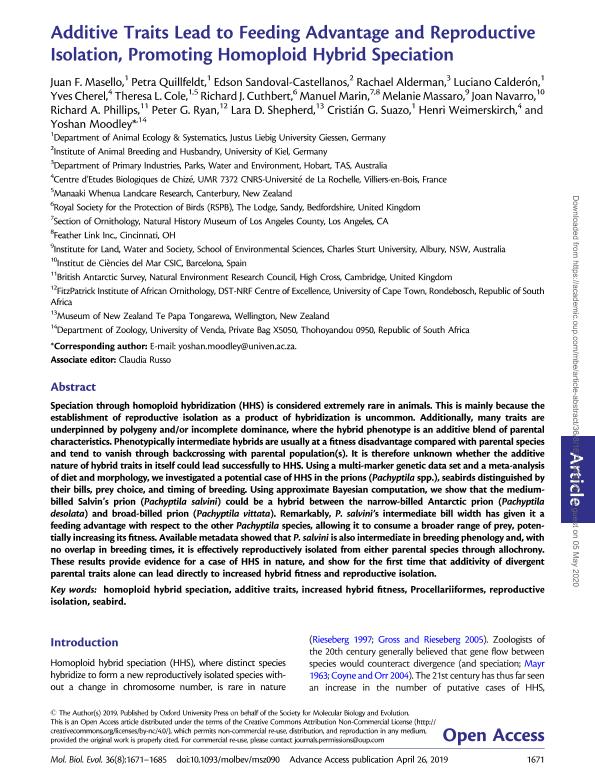Artículo
Additive traits lead to feeding advantage and reproductive isolation, promoting homoploid hybrid speciation
Masello, Juan F.; Quillfeldt, Petra; Sandoval Castellanos, Edson; Alderman, Rachael; Calderón, Pablo Luciano Sebastian ; Cherel, Yves; Cole, Theresa L.; Cuthbert, Richard J.; Marin, Manuel; Massaro, Melanie; Navarro, Joan; Phillips, Richard A.; Ryan, Peter G.; Shepherd, Lara D.; Suazo, Cristián G.; Weimerskirch, Henri; Moodley, Yoshan
; Cherel, Yves; Cole, Theresa L.; Cuthbert, Richard J.; Marin, Manuel; Massaro, Melanie; Navarro, Joan; Phillips, Richard A.; Ryan, Peter G.; Shepherd, Lara D.; Suazo, Cristián G.; Weimerskirch, Henri; Moodley, Yoshan
 ; Cherel, Yves; Cole, Theresa L.; Cuthbert, Richard J.; Marin, Manuel; Massaro, Melanie; Navarro, Joan; Phillips, Richard A.; Ryan, Peter G.; Shepherd, Lara D.; Suazo, Cristián G.; Weimerskirch, Henri; Moodley, Yoshan
; Cherel, Yves; Cole, Theresa L.; Cuthbert, Richard J.; Marin, Manuel; Massaro, Melanie; Navarro, Joan; Phillips, Richard A.; Ryan, Peter G.; Shepherd, Lara D.; Suazo, Cristián G.; Weimerskirch, Henri; Moodley, Yoshan
Fecha de publicación:
04/2019
Editorial:
Oxford University Press
Revista:
Molecular Biology and Evolution
ISSN:
0737-4038
Idioma:
Inglés
Tipo de recurso:
Artículo publicado
Clasificación temática:
Resumen
Speciation through homoploid hybridization (HHS) is considered extremely rare in animals. This is mainly because the establishment of reproductive isolation as a product of hybridization is uncommon. Additionally, many traits are underpinned by polygeny and/or incomplete dominance, where the hybrid phenotype is an additive blend of parental characteristics. Phenotypically intermediate hybrids are usually at a fitness disadvantage compared to parental species and tend to vanish through backcrossing with parental population(s). It is therefore unknown whether the additive nature of hybrid traits in itself could lead successfully to HHS. Using a multi-marker genetic data set and a meta-analysis of diet and morphology, we investigated a potential case of HHS in the prions (Pachyptila spp.), seabirds distinguished by their bills, prey choice and timing of breeding. Using approximate Bayesian computation, we show that the medium-billed Salvin?s prion (P. salvini) could be a hybrid between the narrow-billed Antarctic prion (P. desolata) and broad-billed prion (P. vittata). Remarkably, P. salvini?s intermediate bill width has given it a feeding advantage with respect to the other Pachyptila species, allowing it to consume a broader range of prey, potentially increasing its fitness. Available metadata showed that P. salvini is also intermediate in breeding phenology and, with no overlap in breeding times, it is effectively reproductively isolated from either parental species through allochrony. These results provide evidence for a case of HHS in nature, and show for the first time that additivity of divergent parental traits alone can lead directly to increased hybrid fitness and reproductive isolation.
Archivos asociados
Licencia
Identificadores
Colecciones
Articulos(IBAM)
Articulos de INST.DE BIOLOGIA AGRICOLA DE MENDOZA
Articulos de INST.DE BIOLOGIA AGRICOLA DE MENDOZA
Citación
Masello, Juan F.; Quillfeldt, Petra; Sandoval Castellanos, Edson; Alderman, Rachael; Calderón, Pablo Luciano Sebastian; et al.; Additive traits lead to feeding advantage and reproductive isolation, promoting homoploid hybrid speciation; Oxford University Press; Molecular Biology and Evolution; 36; 8; 4-2019; 1671-1685
Compartir
Altmétricas



